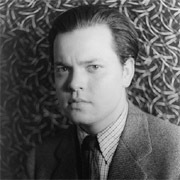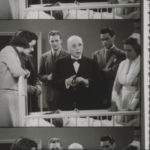For Welles Fans, There’d Never Be “Too Much Johnson.” Until Now.

Little matter that the footage not only is not a finished film, not even a rough cut – it is, rather, 40 minutes of work print, part of what was to have been a longer work that Welles originally intended as supplementary material for a stage play.
Hope of ever finding footage of the film, Too Much Johnson, was low-to-none until some staff members of a cultural organization that regularly screens film classics, Cinemazero, stumbled across a print of it in a shipping-company warehouse in a northern Italian port city.
Ironically, that city, Pordenone, is the site of a leading silent-film event, the annual festival and scholarly gathering, Le Giornate del Cinema Muto. Giving a restored print of Too Much Johnson its world premiere there, on 9 October 2013, was a natural. (The film then had its North American premiere on 16 October 2013 at Eastman House.) “To think that this American silent film has been in Italy for decades, abandoned in the very same city where a major silent film festival is being held—it is just mind-boggling,” says Paolo Cherchi Usai, the senior curator at George Eastman House, in Rochester, NY.
“What’s more, this is a fairy-tale story with a happy ending.”
The find has stunned film-restoration experts, as it has Welles scholars and buffs. All had believed Too Much Johnson forever lost since the only known print – on nitrate stock, a fire’s delight – went up in flames in a 1970 fire that destroyed Welles’s home on the outskirts of Madrid.
The film had, in any case, been left unfinished and never shown in public. That was due to a theatrical failure — Welles’s 1938 adaptation of an 1894 slapstick play by William Gillette, for the Mercury Theatre. Welles and actor-producer John Houseman had formed that New York repertory theater in 1937. Welles’s plan had been to place portions of the film at the beginning of each of the play’s three acts. He cast Joseph Cotten in the lead role. He depicts a womanizer named August Billings who impersonates a Cuban plantation owner to facilitate an affair – a ruse that falls apart when the deceit catches up with him: The man whom he is impersonating turns up, for real.
Mercury Theatre actors were in supporting roles, and in the play. Those included his wife, Virginia Nicholson, under her acting name Anna Stafford. Paul Bowles, a fine writer of fiction (The Sheltering Sky) and screen composer, created the soundtrack. (Films had earlier been made from the play in 1900, as a short, and in 1919, as a Paramount feature, both are lost.)
The discovery of the Too Much Johnson footage, and the beginning of what presumably will be wide distribution and presentation of it, serves as a reminder that Citizen Kane, from 1941, was not Welles’s first work in film, but rather his first feature film. He had been directing films since 1934 — while at Todd School for Boys in Woodstock, Ill., he and a friend made Hearts of Age, Hearts of Age, a short parody of avant-gardism. Too Much Johnson followed in 1938. It consisted of 40 minutes of film that Welles intended to show alongside a revival of the original, 1894 stage version of a farce, Too Much Johnson. It was the first Welles film footage intended for paying customers. But the play was a flop in its first nights at a way-way-off-Broadway theater in Stony Creek, Conn.
At that stage Welles had not finished his film accompaniment, so the footage he had created lost at least its initial reason for existing. Welles didn’t see a print again until the 1960s – he found one at his Spanish home, but couldn’t remember how it got there. In 1978, he told American Film that he had screened it, “and it was in perfect condition, with not a scratch on it. It had a fine quality. Cotten was magnificent.”
Reviewers at both the Pordenone and New York presentations agreed with him. A writer for Silent London, a well-regarded leading British online publication on silent cinema, gushed that watching the restoration “on a big screen, projected from 35mm, with expert piano accompaniment from Philip C. Carli, and commentary from Paolo Cherchi Usai, was dream-like, exhilarating, and occasionally laugh-out-loud hilarious.”
In the New York Times in August 2013, Dave Kehr described Too Much Johnson as impressive even if clearly the work of a young filmmaker: “Welles was all of 23 at the time — with a striking command of his medium. The images are unmistakably his, with their strong, close-cropped compositions, powerful diagonals and insistent, ironic use of the ‘heroic angle’ — the positioning of the camera to look up at the actor as if he were a statue posed on a pedestal.”
Kehr described other key elements of the film: its mimicry of Keystone Kop-like chases – in its case, a pursuit across Lower Manhattan that runs by a suffragist parade. Welles, with Pathé News cameraman Paul Dunbar, shot almost four hours of footage, while a Mercury Theater investor took home movies that show an animated, slim young Welles pretending a flooded Hudson Valley rock quarry is the Caribbean. Kehr outlines the opinion of Simon Callow, an actor and director who later wrote The Road to Xanadu, who said that Welles edited the film in his suite at the St. Regis hotel in Manhattan to try to ready the film in time for the play’s opening in Connecticut. For never-clear reasons, that didn’t happen, Callow wrote, but Welles had got what he needed: “He was a complete tyro, discovering a new medium and unsure how it would work.”
The Restoration
At best estimate, the print discovered in 2008 had sat in the Pordenone warehouse since the 1970s. Fortunately, the Cinemazero staffers who came across it recognized it for what it was and gave it to a major Italian film archive, the Cineteca del Friuli, in nearby Gemona. From there, it went to George Eastman House, which led the painstaking process of restoration from film that ranged from the relatively well preserved to the seriously compromised. That entailed, first, stabilizing the flammable nitrate stock and transferring its images to modern safety stock. The original nitrate print of Too Much Johnson is preserved at Eastman House’s Louis B. Mayer Conservation Center, one of the repositories for the museum’s collection of 28,000 films.Eastman worked with a grant from the San Francisco-based National Film Preservation Foundation, a nonprofit affiliate of the National Film Preservation Board of the Library of Congress — since 1997 it has helped 260 American cultural institutions save their films and has preserved some 200 “lost” American films found abroad. For the preservation work, Eastman House turned to Cinema Arts, an archival-film laboratory in Pennsylvania, and Haghefilm Digitaal laboratories in Amsterdam.
Critical responses to the World and North American premieres speak to the success of the work, as does audience interest: both premieres sold out. With that encouragement, Eastman House’s plan include, at this point, to host a New York screening on 15 November 2013. Eastman House hopes to find funds to offer the film for exhibition via the Internet. No doubt it’ll soon make its way to many locations, around the insatiable Orson Welles world.
Previous Post: Was Hollywood Cozy with Hitler?





















